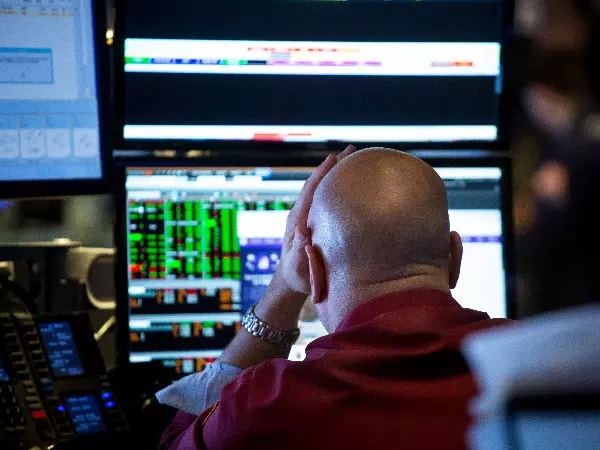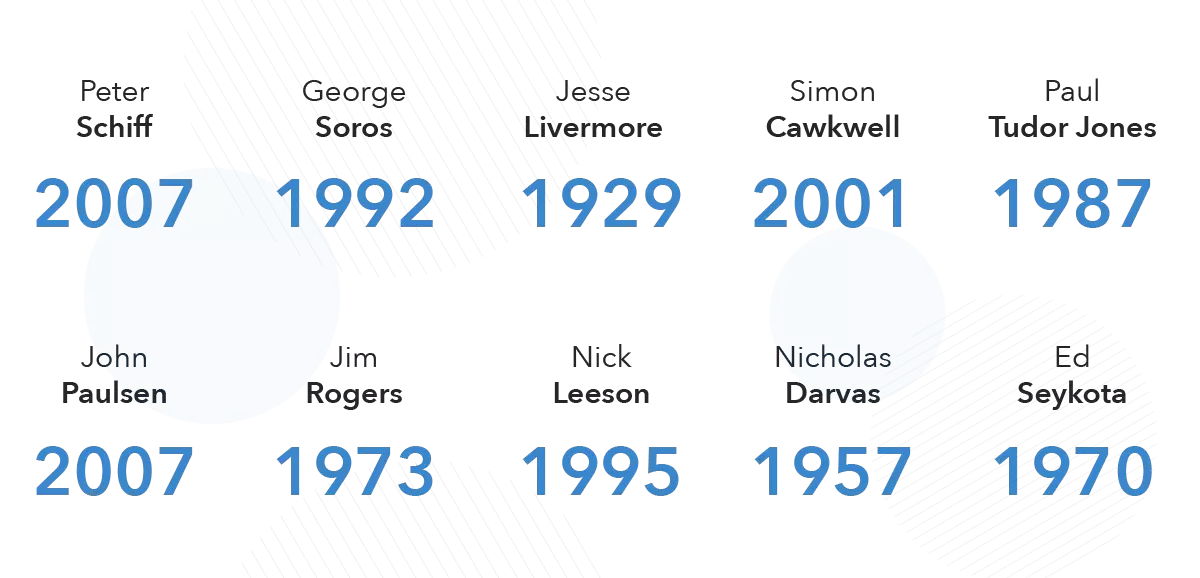World’s most famous traders

Top 10 most famous traders of all time
- Peter Schiff
- George Soros
- Jesse Livermore
- Simon Cawkwell
- Paul Tudor Jones
- John Paulson
- Jim Rogers
- Nick Leeson
- Nicholas Darvas
- Ed Seykota
Note: These are only a few of the traders who have done well or caused disruption in the financial market. They are not necessarily the best traders in history. The list was last updated on 12 August 2019.

Peter Schiff
Peter Schiff, also dubbed ‘Dr Doom’, is an American trader and investor who became famous when he predicted the stock market crash of 2007 to 2010. Born in 1963, he is the son of a prominent tax protestor, who paved the way for Peter’s economic interest. In 2006, Schiff warned of an economic collapse, urging people to take action based on his prediction.
George Soros
Born in 1930, George Soros is one of the most successful forex traders of all time. His bet against the British pound in 1992 reportedly secured $1 billion in profit, earning him the nickname of ‘the man who broke the Bank of England’. He is also a philanthropist, political activist and author.
His most legendary trade was made only days before the British government devalued the pound. Predicting the decision, he leveraged his hedge fund to sell billions of pounds, buying them back at a lower price right after the devaluation. This date became known as Black Wednesday. Soros applied a theory based on the relationship between cause and effect, which helped him get a clear picture of asset bubbles and value discrepancies.
Jesse Livermore
Jesse Livermore belongs among the greats in trading. Born in 1877, his life saw several great crashes, including the 1929 Wall Street Crash. By that time, he had made around $100 million, the equivalent of billions today, having made and lost other fortunes along the way.
He did this without the aid of price charts or algorithms; instead he kept track of prices in a ledger. He developed the concept of pivot points, which involved watching a stock at key levels to see how it reacted. He would add to successful positions in a manner called ‘pyramiding’, by taking progressively smaller positions in a stock to increase his risk and compound his winnings.
Simon Cawkwell
Simon Cawkwell, born in 1946, is a well-known and controversial bear. He famously outs and shorts companies when he believes their share prices will fall. Some of his most famous trades include shorting Northern Bank before it went into administration, and the £1 million he made by shorting shares in the aftermath of the September 11 attacks.
Cawkwell has admitted that he works on the assumption that he is intellectually superior to other traders. He claims that he does not panic when the market moves fast, like others do. He uses his experience as an accountant to think quickly and analyze the fundamental health of a company before shorting.
Paul Tudor Jones
Paul Tudor Jones is synonymous with Black Monday – the stock market crash of 1987. He shorted various stocks during this time and made around $100 million. Jones was born in 1954 and he started his career in finance as a clerk on the trading floor. Five years after his famous trade, he was appointed as the chairman of the New York Stock Exchange (NYSE).
Jones attributes his successful trades to his colleague Peter Borish, who mapped the 1987 market against the 1929 market, which also crashed. He shorted a number of stocks due to the similarity between the two sets of circumstances. His investment philosophy is intricate, but his trading style is mostly based on technical analysis.
John Paulson
John Paulson was born in 1955 and started his financial pursuits in 1976 when he studied business at New York University. He made his millions when he shorted the real estate market during the stock market crisis of 2007. He bet against mortgage-backed securities by investing in credit default swaps, and made roughly $3.7 billion off these trades – launching him into ‘financial legend’ status. He has a reputation for avoiding the media, and rarely gives interviews.
Jim Rogers
Jim Rogers is an American investor and financial commentator born in 1942. He and fellow investor George Soros founded the Quantum Fund in the early 1970s. He is most famous for growing the portfolio by 4200% in just 10 years, along with his long positions on commodities in the 1990s. He has been relentlessly bearish on the US market since the early 80s, predicting that more real estate and consumer debt bubbles are going to burst.
Nick Leeson
Nick Leeson (born 1967) is a derivatives trader who caused the collapse of Barings Bank in 1995. Before the scandal, he was heading up the bank’s operations in Singapore, ensuring massive profits through his trades. However, leading up to the collapse, he placed a few bad trades and started to lose huge amounts of money.
Leeson decided to hide the losses from the bank, as an international oversight meant he did not have to report to a supervisor. He tried to win back the capital by placing more and more speculative bets – including a short straddle on the Nikkei. Unfortunately, the index experienced a sharp drop overnight due to the Kobe earthquake and, despite frantic attempts to recoup the losses, Barings Bank lost more than $1 billion. Leeson decided to flee the country, but he was arrested in Germany and faced four years in prison.
Nicholas Darvas
Nicholas Darvas, born 1920, was a dancer by trade. He became a self-taught investor and made $2 million on the stock market. After some disastrous investments, Darvas set out to learn more about potential high-growth sectors. He then looked for clues in the volume of a stock, waiting for a substantial increase. Then, he narrowed his choices down to stocks trading in a narrow range and waited for a breakout.
What makes his system remarkable is that he did all this in the 1960s, when the only way of keeping in contact with his broker was via telegrams, and even then, these would only reach him infrequently.
Ed Seykota
Many traders call themselves trend followers, but Ed Seykota may perhaps be the greatest of them all. Born in 1946, he began his career when computers still used punch cards, looking to hop on board long trends. His approach was to follow mechanical signals to buy and sell, and then ride out the trend for as long as possible. He stressed the need to follow your system even when it showed a string of losses, since his risk management meant that each losing trade cost him only 1% of his capital.
Like Darvas, he didn’t watch price action all day; instead waiting until the close to update prices. By risking only 1% of his capital on each trade he was able to control his emotions to a greater extent than would have been the case if he risked more. He also avoided making predictions, arguing that the market would tell him what to do when the time came along.
How to become a successful trader
To become a successful trader, you need a clear system that helps you to stay consistent and handle negative market movements. You must also guard against becoming over-emotional. There is no magic formula to becoming a successful trader, but there are a few steps you can take to make sure you’re mastering both the basics and complexities of trading:
- Do your research
- Create a trading plan
- Practice your trades
When you’re ready to take on the markets, you can open a live trading account.
Do your research
Improving your knowledge of financial markets is the first step to becoming a successful trader. Start by researching the different markets available to trade. Remember that you can never know too much; if you want to be a successful trader, you must always aim to improve your knowledge.
Create a trading plan
A trading plan is a blueprint for how you are going to trade. It is driven by your trading strategy, helping you to quantify your goals and motivation. Your trading plan also covers your risk management strategy and preferred analysis method.
Practice your trades
If you want to put your trading plan into practice, you can start trialling your trades on an tastyfx demo account. With a demo account, you can develop your skills without risking your capital right away. Practicing your trades will also help you to refine your trading strategy and learn from any mistakes.
This information has been prepared by tastyfx, a trading name of tastyfx LLC. This material does not contain a record of our trading prices, or an offer of, or solicitation for, a transaction in any financial instrument. You should not treat any opinion expressed in this material as a specific inducement to make any investment or follow any strategy, but only as an expression of opinion. This material does not consider your investment objectives, financial situation or needs and is not intended as recommendations appropriate for you. No representation or warranty is given as to the accuracy or completeness of the above information. tastyfx accepts no responsibility for any use that may be made of these comments and for any consequences that result. See our Summary Conflicts Policy, available on our website.
